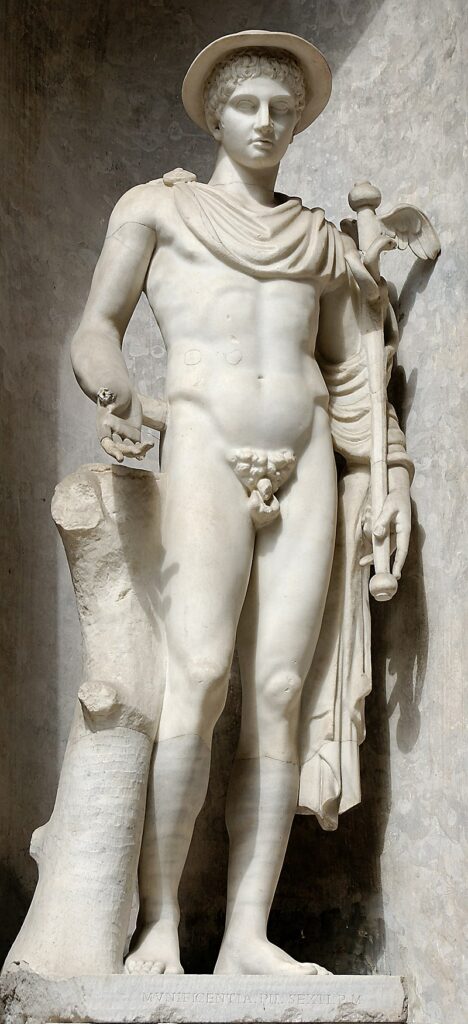According to Ancient Greek mythology, Hermes was known for his cunning and mischievous nature.
On the day he was born, it was said that Hermes invented the lyre, stole 50 head of cattle from his brother Apollo, and then hid the cattle in a cave so well that even Apollo couldn’t find them.
When Apollo discovered his brother’s thievery, he took him to their father, Zeus, hoping that Hermes would be punished appropriately. But when Hermes serenaded Apollo with his lyre, it made him forget all about the thievery.
Apollo was so enthralled by the music that he gave Hermes a staff to show his appreciation.
That staff was known as a caduceus, and it is one of Hermes’ most iconic features.

What Is a Caduceus?
Although we now commonly associate the caduceus with Hermes, it was originally used to refer to any kind of herald’s wand.
The Greek word for this kind of wand or staff is kerykeion, which eventually gave rise to the Latin, caduceus.
Heralds who wielded caducei were employed as aides to kings and often delivered messages. It is no wonder, then, that Hermes, who served as Zeus’ messenger, would also wield a caduceus.
The first mention of a caduceus being used by Hermes dates back to the 6th century BC; however, its history may be much longer. Some scholars believe that ancient Babylonians may have worshiped an earlier version of Hermes, whose civilization lasted from roughly 2000 BC to 540 BC.
This proto-Hermes was considered a god of spring and fertility and was represented by two snakes, one male and one female, wrapped around a rod.
Other theories suggest that the caduceus was inspired by a shepherd’s crook adorned with ribbons. Hermes himself was often regarded as a patron by shepherds.
Whatever the true origins of Hermes and his caduceus, they certainly played a significant role in ancient Greek mythologies. And as it turns out, the caduceus is still used as a symbol today.
But before we get to its modern uses, let’s look at Hermes himself, undoubtedly the most famous owner of a caduceus.
Who Was Hermes, Messenger of the Gods?
Hermes was more than just a trickster. He was also the god of fertility, wealth, sleep, and travel. He was the patron of shepherds and thieves, as well as good luck for travelers.
But one of his most notable attributes was no doubt his ability to cross between Mt. Olympus and Hades – that is, between the living and the dead. He would regularly take mortal souls down to the river Styx, the entrance to the underworld.
Hermes had a fondness for crossing boundaries of all kinds and involving himself in mortals’ affairs. In several Greek tales, Hermes intervenes on behalf of humans.

During the Trojan War, he assists King Priam in recovering the body of his son Hector after Achilles kills him. In the Odyssey, he provides Odysseus with an antidote that protects him from the Goddess Circe and her deadly potions.
Despite being portrayed as a prankster, there is no doubt that Hermes is a powerful god. The caduceus was proof of Hermes’ inviolability, and it even possessed magical properties.
The staff could be used to induce sleep or to determine how a person had died. It was also a symbol of peace. This interpretation most likely stemmed from a legend in which Hermes stopped a fight between two snakes by placing a stick between them. The snakes then intertwined around the stick, creating a caduceus.
Another story about the origins of caduceus has to do with the Greek prophet Tiresias. According to this version, Tiresias had been walking in the woods one day when he saw two snakes mating.
After killing the female snake for no apparent reason, Tiresias was turned into a woman. Seven years later, he returned to the same spot in the woods and found the same snakes mating once again.
This time he killed the male snake, which instantly caused him to turn back into a man. Tiresias then wrapped the two dead snakes around a stick, creating Hermes’ caduceus.
Nowadays, however, Hermes’ staff is most recognizable as a symbol used in medicine. The image of a staff with two snakes coiled around it and topped with wings can be found on medical equipment and in hospitals around the world.
But what do Hermes and his staff have to do with medicine?
The Rod of Asclepius vs Caduceus
The truth is, Hermes doesn’t have much at all to do with medicine. The symbol of the double snake was first used in medicine during the early Renaissance period, but it’s not clear why.
Some scholars believe the double snake represents the duality between sickness and health. Others attribute the use of Hermes’s staff to his role as the patron of alchemists, who, in many ways, paved the way for chemistry.
When it comes to modern medicine, the answer is much clearer. In 1857, the United States Marine Service started using the caduceus as a symbol because they mistakenly believed it was Asclepius’s rod.
Asclepius was the son of Apollo and a god of healing. Like Hermes, he too wields a staff with a snake coiled around it; however, his staff features only one snake rather than two.
As the god of healing, Asclepius appears in several Greek stories, including one in which he saves Rome from a plague by releasing snakes.
These snakes heal Rome’s inhabitants by slithering over them. The idea of a snake being a harbinger of good health may seem counterintuitive, but in Ancient Greece, snakes were indeed associated with healing. Their venom was even thought to have curative properties.
Once one symbol became confused with the other, there was no going back. Now, both the rod of Asclepius and Hermes’ Caduceus are seen as symbols of healthcare worldwide. In fact, according to one estimate, the caduceus is even more commonly found in hospitals than is the rod of Asclepius.
Of course, one place where hospitals don’t make that mistake is in Greece. In the region that gave rise to both Hermes and his staff, those myths have fortunately not been forgotten.
Sources
https://www.ncbi.nlm.nih.gov/pmc/articles/PMC4439707/
https://www.jstor.org/stable/pdf/497115.pdf
Friedlander, Walter J. Golden Wand of Medicine: History of the Caduceus Symbol in Medicine. Greenwood Press, 1992.

